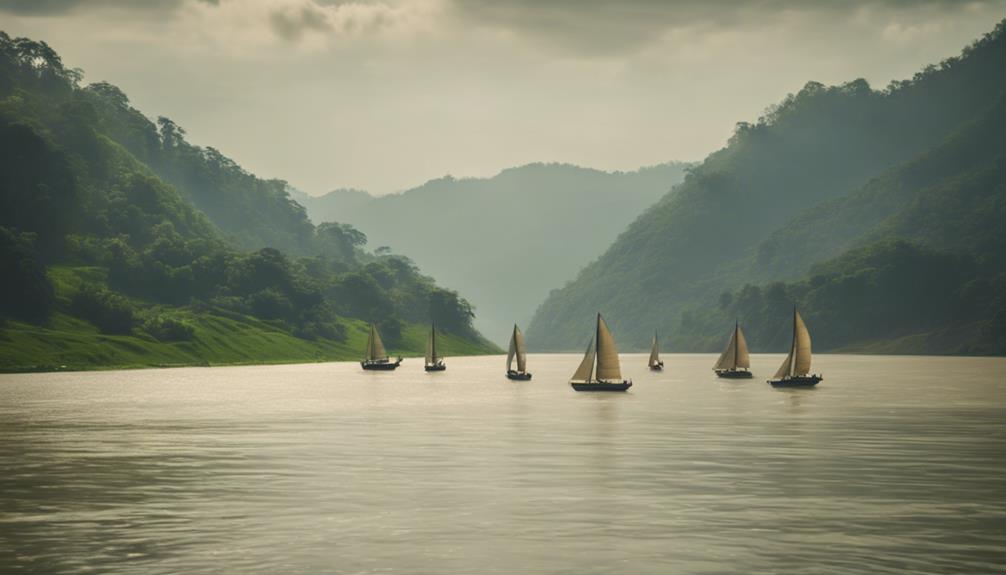As you venture out of Guwahati, you'll discover a treasure trove of cultural and natural wonders within a 100-kilometer radius. Did you know that the world's highest concentration of satras, or Vaishnavite monasteries, can be found in this region? From the intricately woven silk fabrics of Sualkuchi to the majestic rhinos of Pobitora Wildlife Sanctuary, each destination promises a unique experience. But that's not all – there's more to explore, and we're just getting started. What other hidden gems will you uncover in this fascinating region?
Key Takeaways
- Explore Sualkuchi's Silk Village, renowned for its weaving workshops and rich history, just 35 km from Guwahati.
- Discover Barpeta's 16th-century Vaishnavite Monastery, a stunning architectural marvel, only 65 km away.
- Visit the Dispur State Museum, featuring exhibits on Assam's history, art, and culture, just 10 km from Guwahati.
- Trek to the breathtaking Nohkalikai Waterfalls, surrounded by lush greenery, approximately 90 km away.
- Experience the Pobitora Wildlife Sanctuary, home to the Indian one-horned rhinoceros, only 50 km from Guwahati.
Sualkuchi's Silk Village Tour
As you plan your Sualkuchi's Silk Village Tour, you're in for a treat!
You'll get to explore the village's renowned silk weaving workshops, savor authentic Assamese cuisine, and experience the richness of this Silk Village.
Get ready to uncover the intricacies of silk production, interact with skilled artisans, and take back memories (and maybe some exquisite silk souvenirs!) from this enchanting destination.
Overview
You're about to set out on a fascinating journey to Sualkuchi, a village renowned for its thriving silk weaving industry, where traditional craftsmanship and modern techniques blend seamlessly to produce some of the finest silks in the region.
Located just 35 km from Guwahati, this charming village is a treasure trove of history, local legends, and cultural heritage. Known as the 'Manchester of Assam', Sualkuchi has been at the forefront of silk production for centuries, with its skilled weavers creating exquisite fabrics that are highly prized for their quality.
As you explore the village, you'll discover a rich Village History that dates back to the 17th century, when the Mughal Empire brought silk weavers from Bengal to settle in Sualkuchi.
Over time, the village has evolved to become a hub of silk production, with Local Legends passed down through generations of weavers.
Today, visitors can experience the vibrant atmosphere of the village, where traditional weaving units and modern factories coexist in harmony.
Get ready to immerse yourself in the sights, sounds, and stories of this enchanting village, where the art of silk weaving comes alive.
Silk Weaving Workshops Await
Get ready to roll up your sleeves and experience the art of silk weaving firsthand in Sualkuchi's interactive workshops, where skilled artisans will guide you through the intricate process of creating exquisite silk fabrics.
You'll immerse yourself in the world of silk production, learning the secrets of traditional weaving techniques passed down through generations of local artisans. As you work alongside these masters, you'll discover the intricacies of fabric design and the attention to detail required to craft stunning textiles.
Sualkuchi is renowned for its handloom industry, which has been the backbone of the region's textile heritage for centuries. Here, you'll witness the craftsmanship skills of the artisan communities, who take immense pride in their traditional fabrics.
The cultural significance of Sualkuchi's silk village is palpable, and by participating in these workshops, you'll not only take home a beautiful souvenir but also contribute to the preservation of this ancient craft.
As you weave your own silk fabric, you'll forge unforgettable memories and develop a deeper appreciation for the artisans who dedicate their lives to this ancient art.
Try Local Assamese Cuisine
Indulge in the flavors of authentic Assamese cuisine, savoring local delicacies like khar, masor tenga, and aloo pitika, which will leave your taste buds tingling.
As you explore Sualkuchi's Silk Village, take a culinary journey through the region's rich food heritage. Your Foodie Diaries will thank you for the experience!
Treat your taste buds to the bold flavors of traditional Assamese dishes, expertly prepared with locally sourced ingredients.
From the sweet and sour tang of masor tenga to the aromatic spices of aloo pitika, every bite is a sensory delight. As you venture on this gastronomic adventure, you'll discover the perfect blend of spices, herbs, and love that goes into each dish.
Your culinary journey in Sualkuchi's Silk Village isn't just about the food; it's about immersing yourself in the local culture and traditions.
Take a seat at a traditional Assamese kitchen, where the warm hospitality and lively chatter will make you feel like you're part of the family. So, come hungry and curious, and get ready to dive into a flavorful adventure that will leave you craving for more!
Dispur's State Museum Tour

As you step into the Assam State Museum in Dispur, you'll venture on a fascinating journey through the region's rich cultural heritage.
You'll get to explore the museum's impressive exhibits, featuring a vast collection of artifacts, sculptures, and relics that showcase Assam's history, art, and culture.
Now, let's take a closer look at the museum's exhibits, try some local tea stalls, and get an overview of this incredible attraction.
Overview
You'll set out on a fascinating journey through Assam's rich cultural heritage as you step into the Dispur State Museum, a treasure trove of artifacts, exhibits, and displays that bring the region's history and traditions to life.
As you explore the museum, you'll uncover the fascinating story of Guwahati's history, from its ancient roots to its modern-day significance. You can easily reach the museum using local transport, such as buses or autorickshaws, which are readily available from Guwahati's city center.
As you venture deeper into the museum, you'll discover a wide range of exhibits that showcase the region's diverse cultural heritage.
From ancient sculptures to traditional Assamese attire, each exhibit offers a unique glimpse into the region's rich history. The museum's interactive displays and informative plaques make it an engaging and educational experience for visitors of all ages.
Whether you're a history buff, a culture enthusiast, or simply looking for a unique experience, the Dispur State Museum is a must-visit destination that's sure to leave you enthralled and inspired.
Assam State Museum Exhibits
Wandering through the galleries of Dispur State Museum, you're surrounded by a treasure trove of artifacts that reveal the rich cultural heritage of Assam.
As you walk through the museum's elegant corridors, you'll notice the impressive Museum Architecture, a blend of traditional Assamese style and modern amenities.
The museum's Cultural Significance lies in its extensive collection, which showcases the state's history, art, and culture. You'll find exhibits on ancient civilizations, tribal communities, and the region's struggle for independence.
The museum's galleries are divided into sections, each focusing on a specific aspect of Assam's cultural identity.
You'll discover intricately crafted masks, colorful textiles, and ancient sculptures that reflect the region's vibrant artistry.
The museum also houses a vast collection of artifacts, including ancient coins, manuscripts, and sculptures that date back to the 2nd century.
As you explore the museum, you'll gain a deeper understanding of Assam's cultural significance and its importance in India's rich cultural tapestry.
Try Local Tea Stalls
After exploring the Dispur State Museum, refuel with a steaming cup of local tea at one of the many roadside stalls nearby, where the aroma of freshly brewed leaves envelops you in a cozy atmosphere.
As you take a sip, the strong flavors of the Assam tea leaves transport you to a tranquil world, perfect for a mid-morning break.
You can't help but notice the vendors expertly brewing the morning brew, the perfect blend of strong and smooth.
Take a moment to appreciate the simple yet satisfying experience of sipping a hot cup of tea on a bustling street.
As you people-watch, you might even strike up a conversation with the friendly vendors or locals, exchanging stories and laughter.
The tea stalls are more than just a pit stop; they're an integral part of the local culture, offering a glimpse into the daily lives of the people.
Marigaon's Ancient Temple Ruins
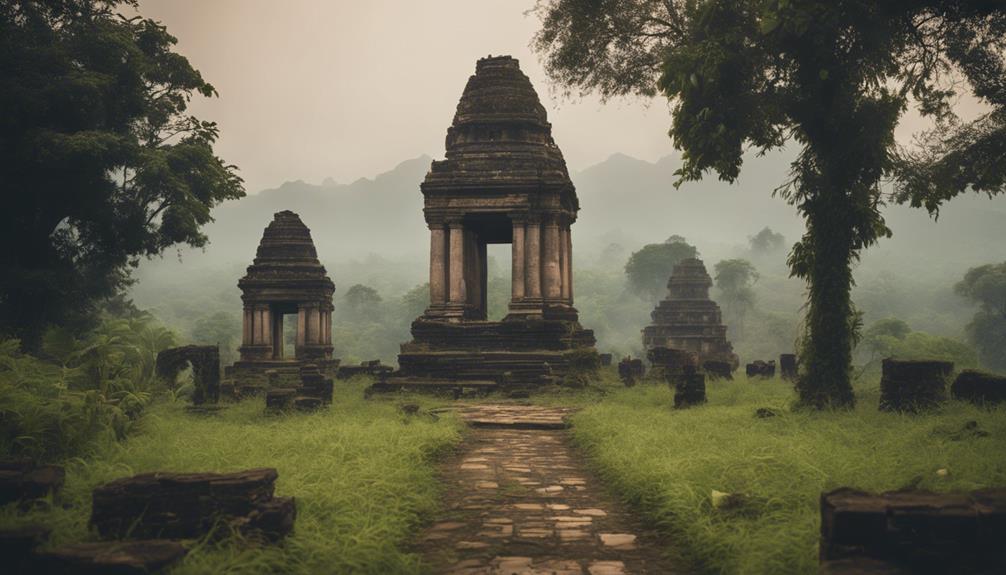
As you venture into Marigaon's ancient temple ruins, you'll be struck by the intricate carvings and sculptures that adorn the remnants of these 9th-century Hindu temples.
You'll soon discover that this archaeological treasure trove offers more than just a glimpse into the region's rich history.
Get ready to explore the intricate carvings, wander through nearby villages, and uncover the secrets hidden within these ancient structures.
Overview
Tucked away in the heart of the Marigaon district, ancient temple ruins wait to be unearthed, whispering secrets of a bygone era.
As you step into this archaeological treasure trove, you'll be transported to a time when Guwahati history was being written. The temple's strategic location, nestled in the Brahmaputra Valley, speaks volumes about the region's significance in ancient Assam geography.
You'll notice how the ruins blend seamlessly into the surrounding landscape, a hallmark of the region's ancient craftsmen.
As you wander through the site, you'll uncover remnants of a once-thriving civilization, with crumbling pillars, intricately carved stones, and mysterious symbols etched into the walls.
The air is thick with an aura of mystique, and you can't help but wonder about the stories these ancient structures could tell. With each step, you'll feel the weight of history beneath your feet, drawing you deeper into the mysteries of Marigaon's ancient temple ruins.
Ancient Temple Carvings Display
You'll be struck by the intricate carvings that adorn the ancient temple walls, where mythical creatures, gods, and goddesses seem to leap out of the stone, their stories waiting to be deciphered.
As you wander through the ancient temple ruins in Marigaon, you'll be amazed by the level of craftsmanship that has withstood the passage of time.
The temple architecture is a reflection of the skill of the ancient artisans who painstakingly carved these intricate designs into the stone walls. The carving techniques used are a marvel, with each figure meticulously crafted to tell a story.
You'll notice the intricate details, from the delicate folds of a goddess's sari to the fierce expression of a mythical creature. Every carving seems to come alive, drawing you into a world of myth and legend.
As you explore the temple, you'll uncover the secrets hidden within the carvings, and gain a deeper appreciation for the artistry and craftsmanship of the ancient civilization that created this masterpiece.
Explore Nearby Villages Freely
Winding your way through the rustic lanes of nearby villages, you'll stumble upon a world untouched by time, where ancient traditions and customs thrive alongside the ruins.
As you explore Marigaon's ancient temple ruins, you'll venture on a Rural Escapade that whisks you away from the hustle and bustle of city life. Village Wanderings become an immersive experience as you navigate the picturesque landscape, where the 9th or 10th-century temple complex stands as a monument to the region's architectural and cultural legacy.
Take a step back in time and breathe in the serene atmosphere that envelops the site. The lesser-known destination is an offbeat gem, perfect for history buffs and those seeking an unconventional experience near Guwahati.
As you wander through the ruins, the air thick with history, you'll uncover the secrets of the region's rich heritage. The journey is as much about the destination as it's about the journey itself, allowing you to disconnect from the urban chaos and reconnect with the natural world and its ancient stories.
Nalbari's Rural Village Life
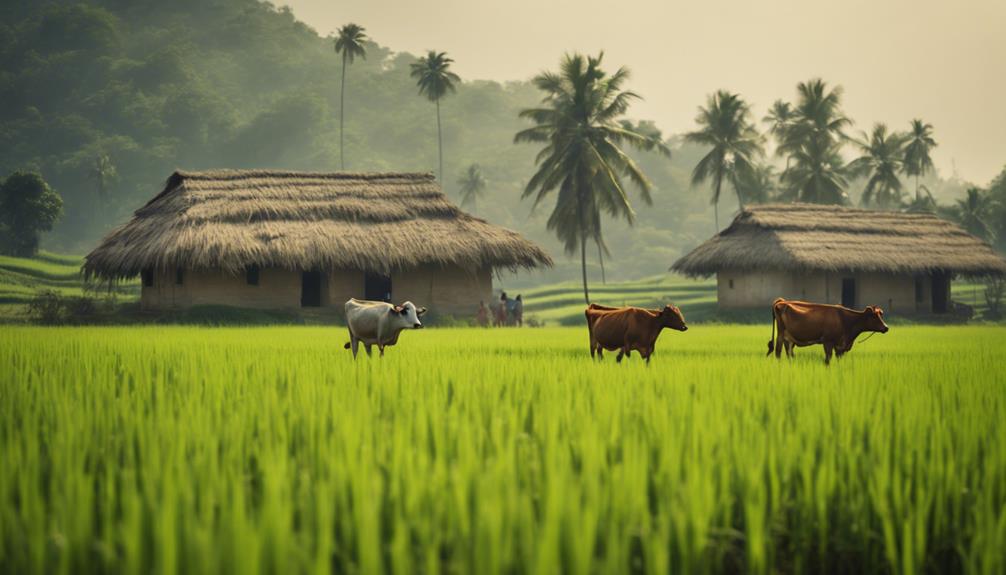
As you step into Nalbari's rural village life, you'll be surrounded by lush green fields and immersed in the traditional Assamese way of living.
You'll have the opportunity to explore the rural villages, interact with the locals, and experience their daily lives firsthand.
From farm tours to trying local street food, you're about to discover the authentic charm of Nalbari's rural village life.
Overview
Nestled in the heart of Assam, Nalbari's rural village life unfolds like a canvas of rustic charm, where the gentle rustle of paddy fields, the soft lapping of rivers, and the rolling hills all conspire to transport you to a world far removed from the frenetic pace of city life.
As you step into this picturesque village, you'll be immersed in a rich cultural heritage, where Village Folklore and Rural Landscapes blend seamlessly. The air is filled with the sweet scent of blooming flowers, and the sound of birdsong echoes through the valleys.
You'll discover ancient temples, like the Hayagriva Madhava Temple, which dates back to the 6th century, and is considered one of the most sacred Hindu temples in the region.
As you wander through the village, you'll get a glimpse into traditional village life, where farming, fishing, and traditional crafts are an integral part of daily life.
With its serene atmosphere and natural beauty, Nalbari is the perfect escape from the hustle and bustle of city life, and a must-visit destination for anyone looking to experience rural Assam.
Rural Village Farm Tours
You'll venture into the heart of Nalbari's rural village life through Rural Village Farm Tours, where the rustic charm of paddy fields, rolling hills, and ancient temples awaits.
As you explore the picturesque villages, you'll engage with local farmers, learn about their daily lives, and even participate in farm activities like paddy transplantation and harvesting.
You'll get to experience the local cuisine, a unique blend of traditional Assamese and tribal flavors, and savor Farm Fresh produce.
During your tour, you'll stay in Village Homestays, immersing yourself in the local culture and way of life.
Led by knowledgeable local guides, you'll gain insight into the region's history, culture, and agriculture.
By participating in Rural Village Farm Tours, you'll not only gain a deeper understanding of rural life but also contribute to the local economy and support sustainable rural development in Nalbari.
With small group sizes, you'll enjoy a personalized and immersive experience, taking back memories of a lifetime.
Try Local Street Food
Your taste buds will dance with joy as you indulge in the flavors of Nalbari's rural village life, where local street food is a symphony of spices, herbs, and love.
As you wander through the village streets, the aroma of sizzling street food wafts through the air, tantalizing your senses.
Be sure to try the popular street food dishes like pitha, a traditional Assamese pancake, or the flavorful jalebi, crispy fried dough soaked in sweet syrup.
If you're feeling adventurous, head to the Street Food Fest, where you can sample a variety of local delicacies, from spicy momos to savory thukpa.
Don't miss the fusion cuisine, a unique blend of traditional Assamese flavors with modern twists.
Savor the flavors of Nalbari's rural village life, where every bite is a culinary celebration. With each mouthful, you'll discover the rich cultural heritage of the region, where food is more than just sustenance – it's a way of life.
Barpeta's Satra Cultural Hub
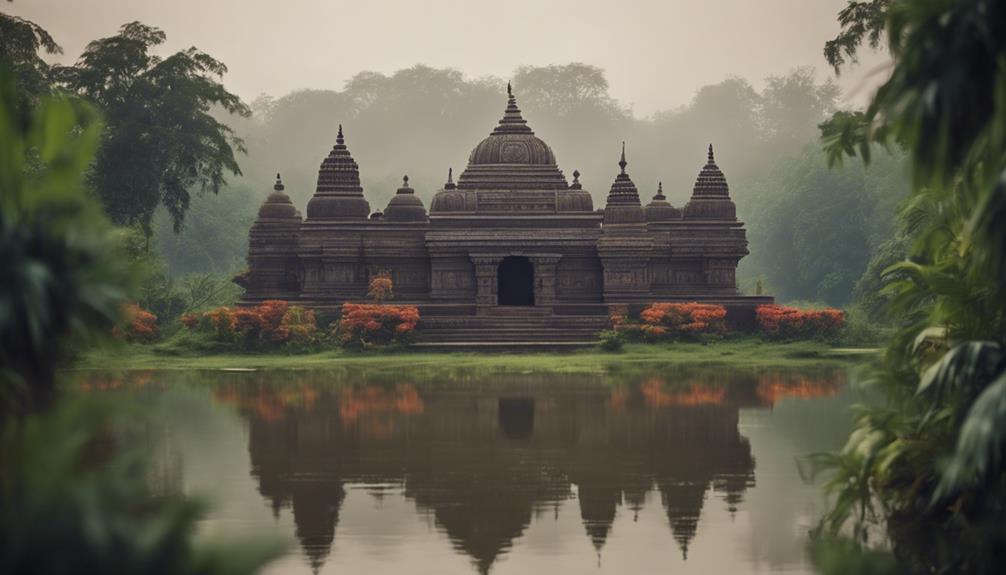
As you explore the charming town of Barpeta, you'll discover a cultural hub that's steeped in history and tradition.
Get ready to immerse yourself in the rich heritage of this iconic satra (monastery), where you'll uncover the secrets of Vaishnavite culture and indulge in the local flavors that'll tantalize your taste buds.
From monastery tours to street food delights, Barpeta's Satra Cultural Hub has a wealth of experiences waiting for you!
Overview
Located about 140 kilometers from Guwahati, the historic town of Barpeta is home to the revered Satra Cultural Hub, a treasure trove of Assamese art, culture, and spirituality.
As you step into this cultural oasis, you'll be transported to a world of rich heritage and traditions. The Satra Cultural Hub is an integral part of Guwahati's history, showcasing the region's vibrant cultural landscape.
As you explore the hub, you'll discover an array of traditional Assamese art forms, including dance, music, and crafts.
You'll get to experience the local way of life, immerse yourself in the region's spiritual practices, and indulge in the local cuisine. The hub is a reflection of Assam's rich tourism potential, offering a unique glimpse into the state's cultural heritage.
Whether you're a history buff, a culture vulture, or simply looking to experience the authentic Assamese way of life, the Satra Cultural Hub is a must-visit destination near Guwahati.
Barpeta's Vaishnavite Monastery Tour
Step into the serene atmosphere of Barpeta's Vaishnavite Monastery, a 16th-century architectural marvel, where the air is alive with the chanting of hymns and the soft rustling of prayer flags.
As you walk through the monastery's ornate gates, you're transported to a world of tranquility and spirituality. The monastery's stunning architecture, with its intricate carvings and ornate domes, is a reflection of the region's rich cultural heritage.
You'll have the opportunity to witness the monks' daily spiritual practices, including their morning prayers and meditation sessions.
Take a stroll through the monastery's peaceful courtyards, adorned with vibrant flowers and lush greenery, and soak up the sense of calm that pervades the atmosphere.
Be sure to explore the monastery's museum, which showcases a fascinating collection of artifacts and relics that offer a glimpse into the region's rich history.
As you explore deeper into the monastery's spiritual practices, you'll gain a deeper understanding of the region's unique cultural identity.
Local Street Food Delights
Indulge in the flavors of Assam at Barpeta's Satra Cultural Hub, where the aroma of sizzling street food wafts through the air, teasing your taste buds and drawing you into a world of culinary delights.
As you explore the hub, you'll discover the vibrant Street Food Culture that Assam has to offer. From crispy fried fritters to savory meat dishes, the local street food scene is a Foodie Heaven.
Savor the flavors of traditional Assamese cuisine, such as khar, masor tenga, and aloo pitika, which are sure to tantalize your taste buds.
The hub's bustling food stalls offer a diverse range of local delicacies, each one showcasing the region's rich culinary heritage.
Whether you're a food enthusiast or just looking to try something new, Barpeta's Satra Cultural Hub is the perfect destination to indulge in the local flavors.
Nongpoh's Pineapple Plantations

As you step into Nongpoh's Pineapple Plantations, you'll be greeted by the sweet aroma of fresh pineapples and the vibrant greenery of the fields.
You're about to experience the thrill of walking through acres of lush pineapple fields, and it's just the beginning of your adventure.
Get ready to explore the plantation, learn about the harvesting process, and indulge in some local treats that will leave you feeling refreshed and delighted!
Overview
Explore the lush landscape of Nongpoh, where emerald green pineapple plantations stretch as far as the eye can see, inviting you to explore the fascinating world of pineapple cultivation.
As you wander through the rolling hills, you'll discover the town's rich history and local legends that have shaped its identity. Nongpoh, located just 45 km from Guwahati, has a charm that's hard to resist.
The town's picturesque landscape, complete with waterfalls and scenic vistas, makes it an ideal getaway for nature lovers and those seeking a quick escape from the city.
As you dig deeper into Nongpoh's history, you'll uncover the stories of local legends and the town's evolution over time.
You'll learn about the people who've lived here for generations, their traditions, and their way of life.
The town's proximity to Guwahati and its natural charm make it an ideal day-trip or weekend getaway destination for locals and tourists alike.
Pineapple Harvesting Experience
Get ready to roll up your sleeves and experience the thrill of plucking fresh pineapples right from the fields at Nongpoh's pineapple plantations, a unique adventure that lets you be a part of the harvesting process!
Located just 45 kilometers from Guwahati, this farm-to-table tourism experience is a must-visit.
You'll get to learn about the entire process of pineapple cultivation, from planting to harvesting, and even participate in the harvesting process itself.
The pineapple harvesting season typically takes place between May and July, with June being the peak season.
You'll be amazed by the sweet and juicy pineapples grown in these plantations, which are sold locally and exported to other parts of the country.
As you wander through the fields, you'll get a firsthand look at the labor of love that goes into cultivating these delicious fruits.
Try Local Pineapple Wine
You're in for a treat as you step into Nongpoh's Pineapple Plantations, where the sweet aroma of ripening pineapples mingles with the promise of a unique wine-tasting experience.
As you explore the 10-acre plantation, you'll discover the secret to their famous pineapple wine. The sweet and juicy Kew variety of pineapple is fermented for 6-8 months to create a sweet and tangy beverage with an ABV of around 12%.
Take a guided tour to learn about the wine-making process, and get to taste the wine along with other local products like pineapple jam and honey. This Wine Tourism experience is a must-try for anyone looking to indulge in Local Flavors.
The pineapple wine makes for a popular souvenir among tourists, and you can even take some back home as a unique reminder of your trip. With its unique flavor profile, this wine is sure to leave you wanting more.
Darang's Ancient Fort Ruins

As you step into Darang's Ancient Fort Ruins, you'll be transported to a bygone era, surrounded by remnants of a rich history.
You'll marvel at the imposing walls that still stand tall, a hallmark of the region's architectural prowess.
Now, get ready to uncover the secrets hidden within these ancient walls and discover the breathtaking views that await you at sunset.
Overview
Located about 65 kilometers from Guwahati, Darang's Ancient Fort Ruins stand as a relic to the region's rich history, beckoning visitors to uncover the secrets of this 4th-century archaeological wonder.
As you approach the fort, you'll be struck by its sheer scale – a 3 km long and 1 km wide earthen rampart, surrounded by a 10-meter-wide and 5-meter-deep moat.
This ancient stronghold is believed to have been built during the reign of the Salasthambha dynasty, making it one of the oldest forts in the region.
Local legends whisper tales of the fort's grandeur, of a time when it was a thriving hub of power and commerce.
Today, the fort's crumbling walls hold secrets of the past, waiting to be unearthed.
Excavations have already revealed a treasure trove of artifacts, including terracotta pottery, coins, and sculptures, now preserved at the Guwahati State Museum.
As you explore the fort, you'll be struck by the sense of history that permeates every stone, every brick.
Ancient Darang Fort Walls
Two imposing walls, each 3-4 meters high, encircle the fort, their rugged, sun-baked bricks silently recounting the tales of a bygone era.
As you walk along the perimeter, you'll notice the intricate stonework and the clever use of arches, typical of ancient fort architecture. The walls are a monument to the ingenuity and craftsmanship of the people who built this fortress centuries ago.
As you explore the ancient Darang Fort walls, you'll begin to appreciate the historical significance of this site. The fort, believed to have been built in the 17th century, has witnessed the rise and fall of empires, and the walls have borne silent witness to the ebb and flow of history.
You can almost hear the whispers of the past, echoing through the empty corridors and gateways.
The fort's architecture is a blend of traditional Indian and Islamic styles, reflecting the cultural exchange and diversity of the region.
The walls, though worn by time, still exude a sense of grandeur and majesty, inviting you to step into the past and relive the stories of a bygone era.
Darang Fort Sunset Views
Perched atop a hill, you'll find the Darang Fort Sunset Views, where the sky is set aflame during the golden hour, offering a breathtaking panorama of the surrounding landscape.
As you stand atop the hill, the ancient fort ruins of Darang Fort, dating back to the 17th century, unfold before you, bearing evidence to the region's rich cultural heritage and historical significance.
The strategic location of the fort on a hilltop provides a vantage point to observe the merging of the Brahmaputra and Bhutan Himalayan ranges, creating a visually stunning sunset experience.
As the day wanes, the sky transforms into a kaleidoscope of colors, a sight that draws tourists and locals alike.
You can reach the Darang Fort Sunset Views by taking a 1.5-hour drive from Guwahati, followed by a short trek to the hilltop, making it an accessible and rewarding excursion.
As you explore the hilltop, the fort's ancient walls and ruins come alive, whispering tales of the past.
Take a moment to soak in the tranquility of the surroundings, and let the majestic sunset views leave you spellbound.
Pobitora Wildlife Sanctuary

As you venture into the Pobitora Wildlife Sanctuary, you'll discover a haven for the majestic Indian one-horned rhinoceros, with a chance to get up close and personal with these incredible creatures.
With guided tours and elephant safaris, you'll have the opportunity to explore the sanctuary's rich biodiversity, including Asiatic buffaloes, leopards, and over 200 species of birds.
Get ready to immerse yourself in the natural beauty of Pobitora, where conservation and research efforts come alive.
Overview
Just 30 kilometers from Guwahati, you'll stumble upon Pobitora Wildlife Sanctuary, a protected haven where the majestic Indian one-horned rhinoceros roams free.
As you step into this 38.8-square-kilometer sanctuary, you'll be surrounded by a diverse array of flora and fauna. With over 200 species of birds, 10 species of reptiles, and 15 species of mammals, Pobitora is a haven for wildlife enthusiasts.
The sanctuary's densest one-horned rhino population, with over 90 rhinos per square kilometer, makes it an ideal spot for eco-tourism. By visiting Pobitora, you'll be supporting wildlife conservation efforts, as the sanctuary has been recognized as one of the best-managed in the country.
From November to April, you can take guided tours to explore the sanctuary, getting up close and personal with these incredible creatures. With its rich biodiversity and commitment to conservation, Pobitora Wildlife Sanctuary is a must-visit destination for anyone passionate about eco-tourism and wildlife conservation.
Rhino Spotting Opportunities
Stepping into Pobitora Wildlife Sanctuary, you'll be on the lookout for the majestic one-horned rhino, and with a staggering density of 83.3 rhinos per 100 square kilometers, the chances of spotting these incredible creatures in their natural habitat are higher than ever.
As you venture into this natural haven, you'll notice the lush grasslands and forests that provide the perfect rhino habitats. The sanctuary's conservation efforts have played a vital role in preserving the natural balance, allowing the rhino population to thrive.
With guided jeep safaris and elephant rides, you'll get up close and personal with these gentle giants.
The winter months from November to February are the best time to visit, as the dry grasslands make it easier to spot the rhinos.
As you explore Pobitora, you'll not only catch a glimpse of the majestic one-horned rhino but also get a deeper understanding of the importance of conservation efforts in preserving these incredible creatures and their habitats.
Wild Elephant Spotting Tips
Venture into Pobitora Wildlife Sanctuary, and you'll not only spot majestic one-horned rhinos but also have the chance to encounter wild elephants, provided you're guided by experienced forest experts who know the habitat and behavior of these gentle giants.
As you explore the sanctuary's grasslands and forests, you'll increase your chances of spotting these majestic creatures in their natural habitat.
To make the most of your wildlife encounter, opt for a guided tour with experienced forest guides who know the best spots to track these gentle giants.
Remember to maintain a safe distance from the elephants, as they're wild animals and may charge if they feel threatened or surprised.
As you navigate through the sanctuary, keep an eye out for the diverse range of bird species, with over 200 documented within the area.
With the scenic views of the surrounding hills as your backdrop, Pobitora Wildlife Sanctuary is the perfect destination for an unforgettable wildlife encounter.
Nohkalikai Waterfalls Trek
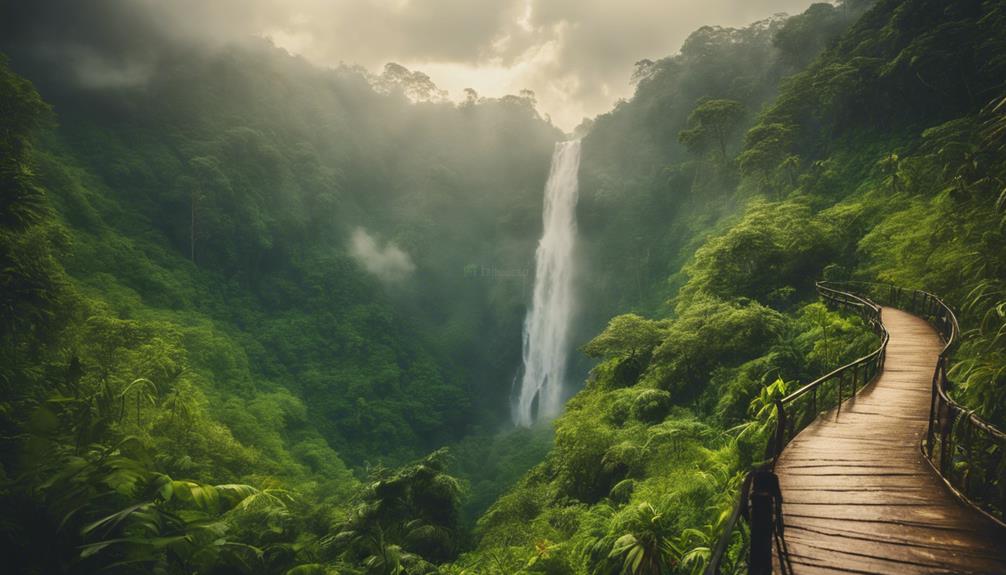
As you set out on the Nohkalikai Waterfalls Trek, you'll be rewarded with breathtaking views of the 335-meter waterfall, surrounded by lush greenery.
You'll have the opportunity to explore the scenic waterfall viewing decks, where you can take in the misty veil of the falls and capture stunning photos.
Get ready to spot wildlife and click away, as the trek offers plenty of opportunities for wildlife photography.
Overview
Venture into the heart of Meghalaya's lush landscape on the Nohkalikai Waterfalls Trek, a scenic adventure that promises breathtaking views and an unforgettable experience.
As you set out on this 2 km trek, you'll be surrounded by the region's untamed beauty, with villages, hills, and dense forests unfolding before your eyes. The trek, which takes around 2-3 hours to complete, is a nature lover's paradise, offering a chance to disconnect from the hustle and bustle of city life and reconnect with nature.
As you make your way through the trek, you'll catch glimpses of the majestic Nohkalikai Waterfalls, India's highest waterfall, plunging 335 meters into the depths below.
The misty atmosphere and lush green surroundings create a picturesque scene, especially during the monsoon season from June to September. This is Meghalaya Tourism at its best, offering a unique Nature Escapes experience that will leave you awestruck.
Scenic Waterfall Viewing Decks
Upon arriving at the scenic viewing decks, you'll be treated to a breathtaking panorama of Nohkalikai Waterfalls, with the roaring waters plunging 335 meters into the depths below.
As you take in the stunning view, you'll notice the carefully designed viewing decks, built to guarantee Waterfall Safety while providing an unobstructed view of the falls. The Deck Design is cleverly constructed to blend seamlessly into the natural surroundings, allowing you to focus on the majestic waterfall.
As you gaze out at the falls, you'll appreciate the lush greenery surrounding you, especially during the monsoon season when the water flow is at its peak.
The trek to the viewing decks is approximately 2 kilometers long and takes around 2-3 hours to complete, depending on your pace. Take your time, and soak in the serenity of the surroundings. Remember to stay safe and follow Waterfall Safety guidelines to guarantee a memorable and enjoyable experience.
The scenic viewing decks are the perfect spot to relax, unwind, and marvel at the natural beauty of Nohkalikai Waterfalls.
Wildlife Photography Opportunities
With your camera at the ready, you'll find the Nohkalikai Waterfalls Trek a veritable treasure trove of wildlife photography opportunities, set amidst the lush green surroundings of Cherrapunjee, Meghalaya.
As you set out on this 10-kilometer trek, you'll have ample time to observe and capture the diverse flora and fauna of the region. The trek's moderately difficult terrain requires a certain level of physical fitness, but the scenic beauty and wildlife photography opportunities make it a rewarding experience.
During the monsoon season, from June to September, the waterfalls are at their peak, and the surroundings are lush and green, providing ideal conditions for capturing stunning photographs.
With a keen eye, you'll spot rare and endangered bird species, making this trek a wildlife conservationist's paradise. Adjust your camera settings to capture the play of light on the waterfalls, and experiment with different angles to frame the breathtaking views.
Remember to respect the natural habitat and adhere to responsible wildlife photography practices, ensuring that your shutter clicks contribute to the conservation of this incredible ecosystem.
Nagaon's Ancient Temple Ruins
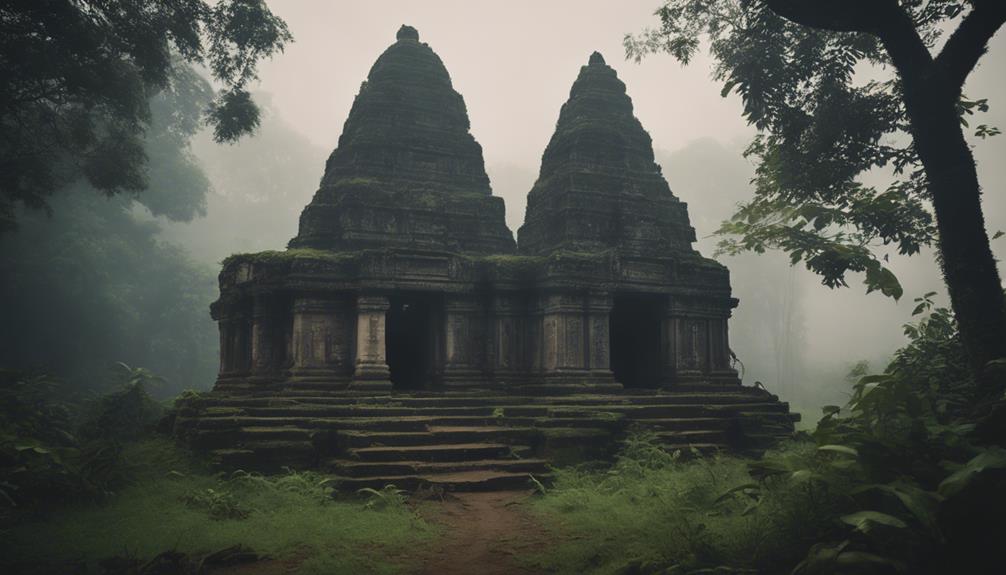
As you venture into the Nagaon district, you'll stumble upon ancient temple ruins that will transport you back in time.
You'll discover remnants of a bygone era, where intricate carvings and sculptures whisper secrets of the past.
Get ready to unravel the mysteries of these ancient structures, and uncover the stories hidden within their crumbling walls.
Overview
Exploring the ancient temple ruins in Nagaon, you'll uncover a treasure trove of Assam's rich cultural heritage, nestled amidst a picturesque landscape that whispers secrets of the past.
As you wander through the ruins, you'll discover the historic significance of this site, which dates back to the 4th or 5th century. The temple's architecture and artwork are a reflection of the advanced craftsmanship of the ancient Assamese people, showcasing their cultural preservation efforts.
The site's broken pillars, stone slabs, and other remnants offer a glimpse into the region's architectural and artistic traditions.
Surrounded by a breathtaking landscape, the temple ruins are an ideal destination for history buffs and nature lovers alike. What's more, this lesser-known gem near Guwahati offers a unique opportunity to explore Assam's cultural heritage without the crowds.
Ancient Shiva Temple Ruins
Nestled in the heart of Nagaon, the ancient Shiva Temple Ruins stand as a legacy to the region's spiritual heritage, beckoning you to unravel the mysteries hidden within its crumbling walls and intricate stone carvings.
As you step into the temple complex, you're surrounded by whispers of Shiva legends, echoing through the centuries. The air is thick with an otherworldly energy, as if the temple's ancient stones hold secrets waiting to be unearthed.
As you wander through the ruins, you'll notice the intricate carvings that adorn the walls, telling stories of Shiva's mighty exploits.
The temple's architecture is a reflection of the region's rich cultural heritage, a blend of ancient traditions and mythological tales.
You can't help but feel drawn to the mystique of the temple, its crumbling grandeur a poignant reminder of the transience of human creation.
The temple's mysteries beckon you to explore further, to uncover the secrets hidden within its ancient stones.
Will you answer the call, and let the whispers of the Shiva legends guide you through the temple's ancient heart?
Ancient Shiva Idol Secrets
Standing before the ancient Shiva idol, you're face to face with a 10-foot-tall masterpiece of black granite, its intricate carvings and majestic presence drawing you into the mystical world of Lord Shiva.
As you gaze upon the idol, you can't help but wonder about the granite mysteries hidden within its ancient stones. The whispers of the idol seem to echo through the centuries, sharing secrets of the past with those who dare to listen.
The idol, carved out of black granite, depicts Lord Shiva in the 'Umamaheshwar' form, accompanied by Parvati and Ganesh.
The intricate carvings on the idol showcase the exceptional craftsmanship of ancient Indian artistry.
As you explore the temple complex, you'll discover several other ancient idols and sculptures, including a 6th-century AD idol of Lord Vishnu.
The Archaeological Survey of India (ASI) protects this archaeological site, ensuring its preservation for generations to come.
As you plunge deeper into the ancient Shiva idol's secrets, you'll uncover the rich history and mystique surrounding this revered site.
Frequently Asked Questions
Which Is the Most Beautiful Place of Assam?
You're wondering which place in Assam takes the crown for beauty? For you, it's Kaziranga National Park, where rolling Assam Tea Gardens meet the majestic Kaziranga Wildlife, creating a breathtaking symphony of nature's splendor.
How Many Places Are Near Guwahati?
You might think there aren't many options, but you're wrong! Guwahati has plenty of local attractions and weekend getaways waiting to be explored, with over 15 exciting spots within a 100-km radius, all ready to be discovered by you!
Where to Visit Between Siliguri and Guwahati?
As you drive between Siliguri and Guwahati, consider stopping in Nalbari, a charming town near the Bhutan borders, perfect for a scenic break or a Cherrapunji excursions detour, before continuing your journey.
What Is the Best Time to Visit Near Guwahati?
You'll discover the best time to visit near Guwahati is from October to March, when pleasant weather conditions prevail, minimizing the tourist rush, allowing you to soak in the serene atmosphere and explore the region's hidden gems.
Conclusion
As you explore the hidden gems near Guwahati, the rich cultural heritage of Assam unfolds like a tapestry.
You've woven a narrative of tradition, history, and natural beauty, with each thread telling a story of its own.
Now, the ball is in your court – take the leap and immerse yourself in the vibrant fabric of Assam, where every experience is a thread that enriches your travel tale.
